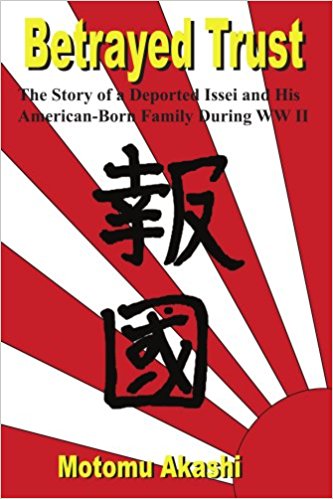Betrayed Trust: The Story of a Deported Issei and His American-Born Family During World War II (book)
Creators: Motomu Akashi
A Nisei shares his family's heart-wrenching experience of wartime incarceration and the complex background behind their decision to go to Japan instead of staying in the U.S. after the end of the war.
Synopsis
In the preface, the author explains that he wrote this book in order to find out more about his father who, during World War II, was a member of a group at Tule Lake concentration camp that advocated repatriation to Japan instead of remaining in the U.S.
Akashi begins with a brief history of his father, who immigrated to the U.S. in 1912 and studied agriculture. As a farmer, including at the Cortez extension of the Yamato Colony founded by Kyutaro Abiko , his father was disappointed by the opposition and discrimination Japanese farmers faced, but believed that Japanese farmers could change the minds of those who objected to their presence by working hard and being good neighbors. He married Vivian, a Nisei , in 1926, and the family moved around, with the father working as a farmer as well as a Japanese language school teacher. Motomu describes a comfortable childhood.
When Pearl Harbor was attacked, the Akashis destroyed everything Japan-related they had. The father was briefly detained by the FBI but released after a few days. Motomu describes their neighbors' changed attitudes towards them, as well as the painful process of preparing for incarceration. They were first taken to Tanforan Assembly Center , then to Topaz concentration camp. Akashi reflects on the difficulty of adjusting to a new life with new neighbors and the breakdown of old community and family ties. He also details the gradual shift in his father's thinking from exhorting his sons to be prepared to do anything for the sake of their country to deciding that it was in the family's best interests to repatriate (expatriate, in the case of the children) to Japan.
The remainder of the book recounts the family's transfer to Tule Lake , Akashi's father's growing involvement in a group, the Hokoku Hoshi Dan, that urged the resegregation of those requesting repatriation from those who were more aggressively pro-Japanese, the author and his brother's involvement in the Sokoku Dan (a group of Nisei whose parents were repatriating), and the other diverse and complicated groups vying for influence among the inmates in Tule Lake. He concludes with a retelling of the family's journey to Japan—including their uncertainty that their father would join them, since he had been detained in Santa Fe internment camp at the end—and the misery of life in Occupied Japan when they finally arrived.
Author Background
Motomu Akashi (1929-2012) worked in military intelligence for over twenty years, was a veteran of both the Korean and Vietnam wars, and received numerous awards and commendations. After retirement, he dedicated much of his time to researching family history, with this book as the result.
Find in the Digital Library of Japanese American Incarceration
Betrayed Trust: The Story of a Deported Issei and His American-Born Family During World War II
This item has been made freely available in the Digital Library of Japanese American Incarceration , a collaborative project with Internet Archive .
Might also like:
Tule Lake: An Issei Memoir
by Noboru Shirai;
Beyond Loyalty: The Story of a Kibei
by Minoru Kiyota;
In Defense of Justice: Joseph Kurihara and the Japanese American Struggle for Equality
by Eileen H. Tamura
| Author | Motomu Akashi |
|---|---|
| Publication Date | 2004 |
For More Information
Obituary, Motomu (Tom ) Akashi . East Bay Times , Oct. 4–5, 2012.
